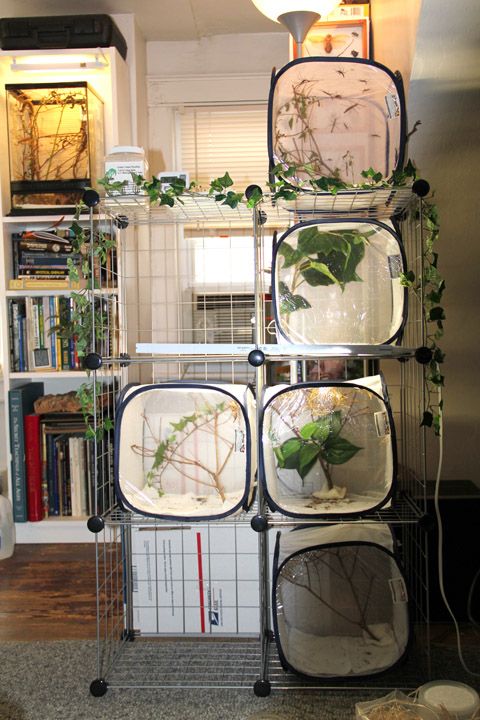Precarious
Well-known member
Hiya! 
I'm here to give you the basics of keeping your mantis happy. If you are new to keeping mantids this is a great place to start!
There are a few things you need to keep in mind when deciding how to house your new pet(s). First off, most mantids L :tt1: VE to hang upside-down. They spend nearly their whole life hanging from the ceiling of whatever enclosure you put them in. So don't be surprised by that.
With this in mind you could say the ceiling is the most important part of the enclosure. It's where they will spend the majority of their time. AND they will most likely molt from the ceiling too, so make sure it is a material they can grip really well. Many mantis species can't grip smooth plastic and even if they can plastic is not an ideal surface to molt from. Choose something with a natural texture, like twigs, bark or branches. For most species, nylon or wire screen is also a good choice, or any kind of cloth mesh like they use for mesh laundry bags. You can glue it or use wire ties to hold it in place.
I get these at the dollar store...
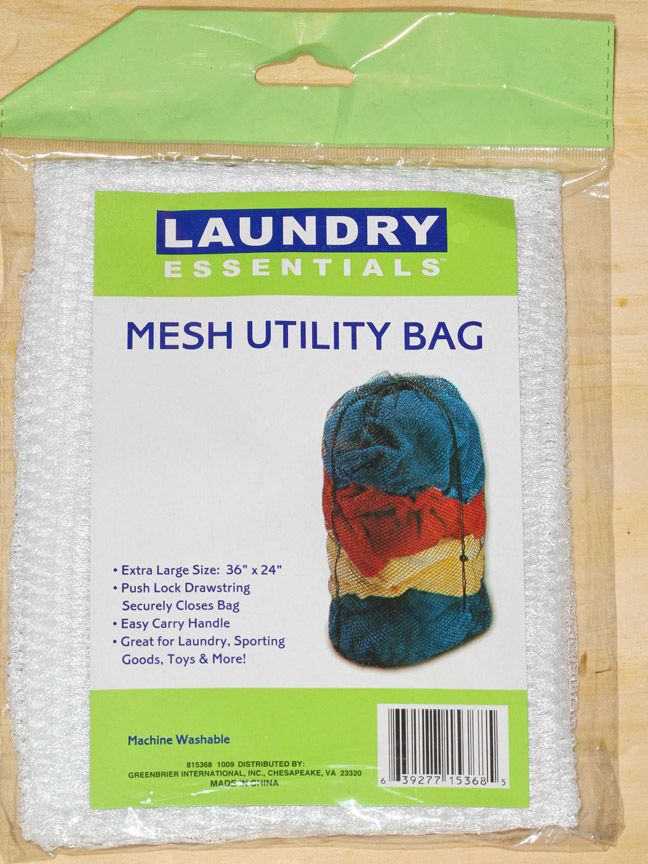
Bonus Points: Guess how much they cost. :smarty:
If your mantis is small enough a 16 or 32 oz deli cup will do just fine. Use a cloth lid if you have a species that requires high humidity or if you need to keep fruit flies in. Otherwise a screen lid will allow better ventilation. It's also a good idea to make a hole in a cloth lid and plug it with some foam or paper towel. That way you can feed and mist your pet without taking off the lid. That eliminates the danger of accidentally pinching their legs in your rush to keep the food from escaping. A feeding hole is absolutely essential when dealing with a group of young nymphs. I use a funnel to dump in fruit flies. Works like a charm!
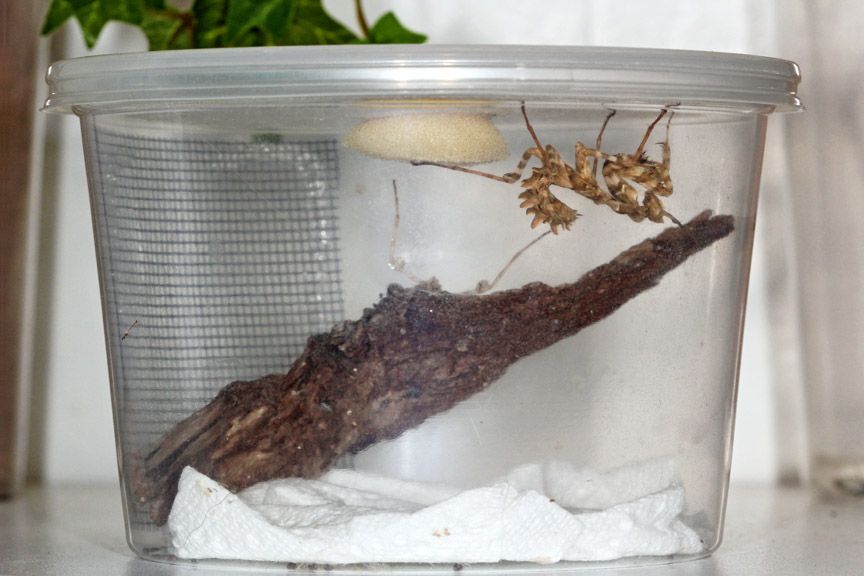
Blepharopsis mendica nymph in 16 oz deli cup with cloth lid, sponge-plugged feeding hole, screen wall and bark for climbing.
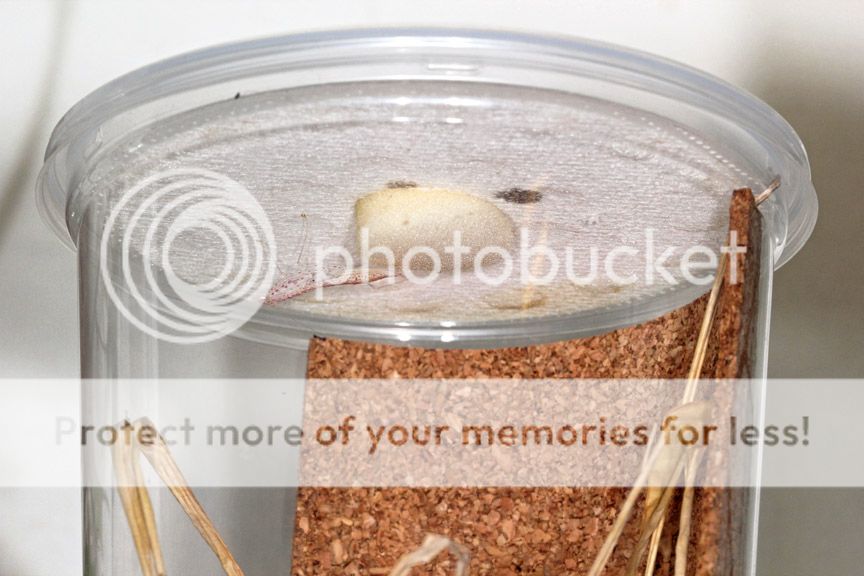
Sinomantis denticulata in 32 oz deli cup with cloth lid, sponge-plugged feeding hole, and cork bark wall.
The second most important part of your enclosure is how your mantis will climb to and from the ceiling. It's good to have at least one branch or vine they can climb all the way up in case they fall or need to climb down to food. One branch is fine for a deli cup. I like to hot glue a square of screen or cork bark to the side. That way they'll always have a surface to climb without giving up any space. Some people just use sandpaper to add texture to the plastic. Whatever you decide, make sure your mantis can get up and down without much difficulty.
The third thing to consider is what to do with the floor. I usually use a square of paper towel or foam. It's a good way to hold humidity and very easy to clean. Personally, I don't recommend moss or any kind of substrate, especially in something as small as a deli cup. Too much trouble and potentially too much humidity in such a small space. If, on the other hand, you're making a nice big terrarium for your mantis moss is great. I like to keep a shallow dish of moss in my tanks. That way I can add water without wetting everything else in the tank, which helps prevent mold, and it's easy to take the dish out if you need to clean the moss. You don't want the floor too complicated because all that will do is give crickets and roaches more places to hide!
Oh, and there are net cages too which are great! Lay paper towel, add some branches and you're good to go. Just remember you'll have to mist more often if your pet needs higher than average humidity.
So that's it! Those are the basics;
1.) a ceiling of material they can grip really well
2.) a means of going up and down
3.) something covering the floor that holds some humidity
The rest is a matter of personal taste. Some keep things as simple as possible. Others hot glue silk flowers and vines to spice things up.
And some just go a little too far like these nutjobs...
Terrarium with lots of twigs
New Idolo Tank
Welcome to SpongeWorld!
More examples...
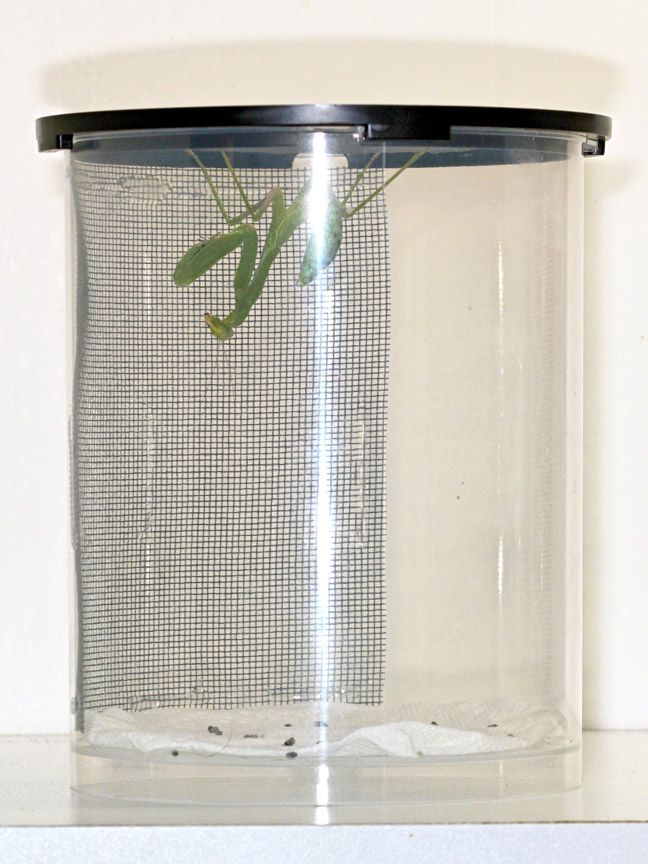
Sphodromantis viridis in enclosure made from 100 count DVD spindle. The black base is now the lid which has been cut out and covered with screen. Paper towel in the bottom and screen glued to one wall. More room than a 32 oz deli cup!
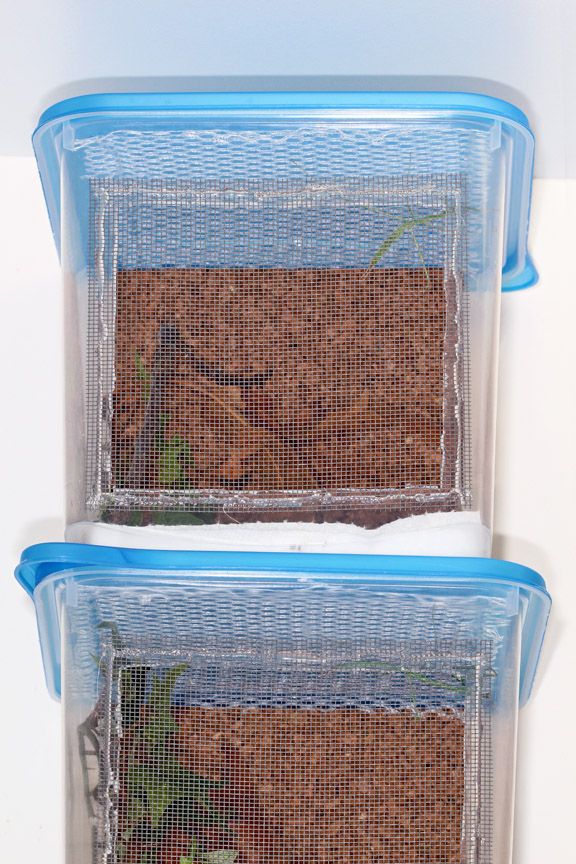
Brunneria borealis in enclosures made from $1 food storage containers. One wall replaced with screen for better ventilation. Ceiling covered with mesh, rear wall covered with cork bark, branches and vines for climbing.
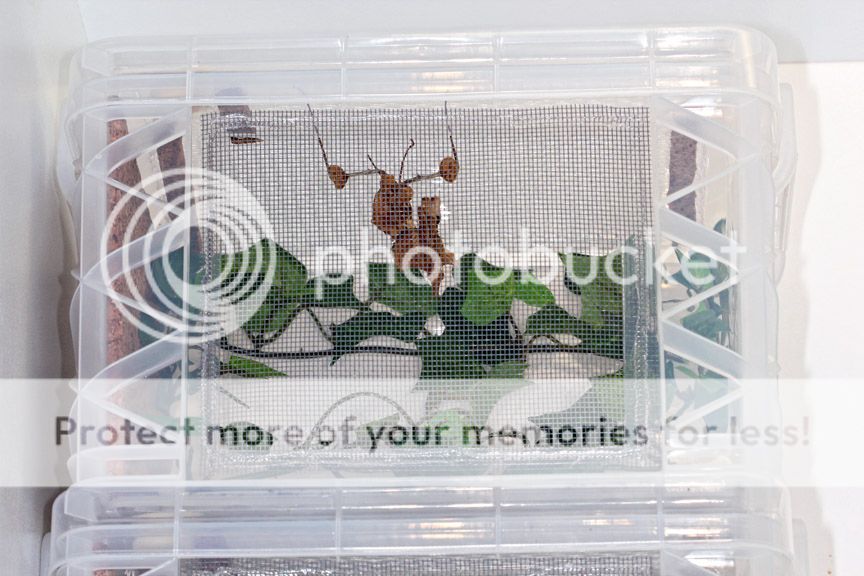
Idolomantis diabolica in converted storage bin. Ceiling covered with mesh and fitted with feeding hole. Side wall covered in cork bark, floor with paper towel, front wall replaced with screen, and vines for climbing.
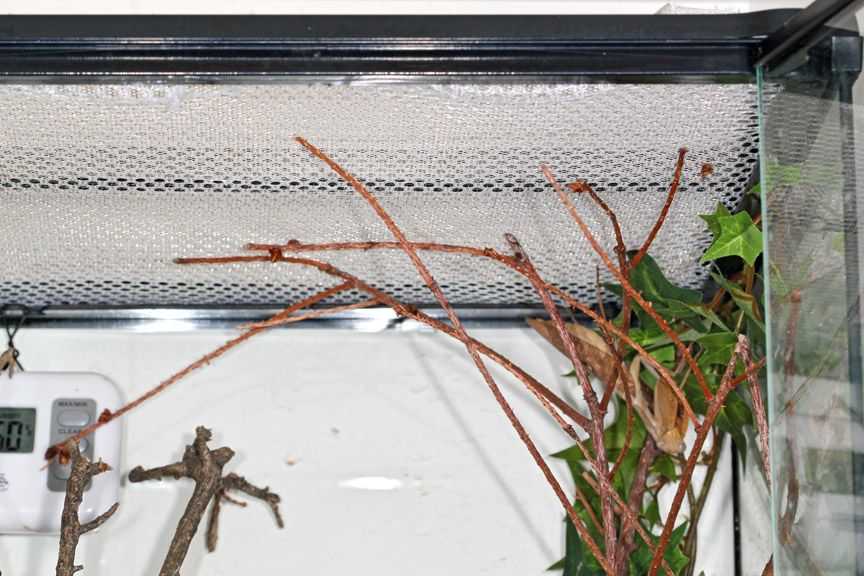
Sphodromantis sp. adult female in Exo-Terra 12"x12"x12" tank. Screen covered in mesh, branched and vines floor to ceiling.

Idolomantis diabolica adult male in 12"x12"x18" Zoo Med tank. Ceiling covered with twigs, rear wall covered in bamboo place mat, walls lined with branches.
I'm here to give you the basics of keeping your mantis happy. If you are new to keeping mantids this is a great place to start!
There are a few things you need to keep in mind when deciding how to house your new pet(s). First off, most mantids L :tt1: VE to hang upside-down. They spend nearly their whole life hanging from the ceiling of whatever enclosure you put them in. So don't be surprised by that.
With this in mind you could say the ceiling is the most important part of the enclosure. It's where they will spend the majority of their time. AND they will most likely molt from the ceiling too, so make sure it is a material they can grip really well. Many mantis species can't grip smooth plastic and even if they can plastic is not an ideal surface to molt from. Choose something with a natural texture, like twigs, bark or branches. For most species, nylon or wire screen is also a good choice, or any kind of cloth mesh like they use for mesh laundry bags. You can glue it or use wire ties to hold it in place.
I get these at the dollar store...

Bonus Points: Guess how much they cost. :smarty:
If your mantis is small enough a 16 or 32 oz deli cup will do just fine. Use a cloth lid if you have a species that requires high humidity or if you need to keep fruit flies in. Otherwise a screen lid will allow better ventilation. It's also a good idea to make a hole in a cloth lid and plug it with some foam or paper towel. That way you can feed and mist your pet without taking off the lid. That eliminates the danger of accidentally pinching their legs in your rush to keep the food from escaping. A feeding hole is absolutely essential when dealing with a group of young nymphs. I use a funnel to dump in fruit flies. Works like a charm!

Blepharopsis mendica nymph in 16 oz deli cup with cloth lid, sponge-plugged feeding hole, screen wall and bark for climbing.

Sinomantis denticulata in 32 oz deli cup with cloth lid, sponge-plugged feeding hole, and cork bark wall.
The second most important part of your enclosure is how your mantis will climb to and from the ceiling. It's good to have at least one branch or vine they can climb all the way up in case they fall or need to climb down to food. One branch is fine for a deli cup. I like to hot glue a square of screen or cork bark to the side. That way they'll always have a surface to climb without giving up any space. Some people just use sandpaper to add texture to the plastic. Whatever you decide, make sure your mantis can get up and down without much difficulty.
The third thing to consider is what to do with the floor. I usually use a square of paper towel or foam. It's a good way to hold humidity and very easy to clean. Personally, I don't recommend moss or any kind of substrate, especially in something as small as a deli cup. Too much trouble and potentially too much humidity in such a small space. If, on the other hand, you're making a nice big terrarium for your mantis moss is great. I like to keep a shallow dish of moss in my tanks. That way I can add water without wetting everything else in the tank, which helps prevent mold, and it's easy to take the dish out if you need to clean the moss. You don't want the floor too complicated because all that will do is give crickets and roaches more places to hide!
Oh, and there are net cages too which are great! Lay paper towel, add some branches and you're good to go. Just remember you'll have to mist more often if your pet needs higher than average humidity.
So that's it! Those are the basics;
1.) a ceiling of material they can grip really well
2.) a means of going up and down
3.) something covering the floor that holds some humidity
The rest is a matter of personal taste. Some keep things as simple as possible. Others hot glue silk flowers and vines to spice things up.
And some just go a little too far like these nutjobs...
Terrarium with lots of twigs
New Idolo Tank
Welcome to SpongeWorld!
More examples...

Sphodromantis viridis in enclosure made from 100 count DVD spindle. The black base is now the lid which has been cut out and covered with screen. Paper towel in the bottom and screen glued to one wall. More room than a 32 oz deli cup!

Brunneria borealis in enclosures made from $1 food storage containers. One wall replaced with screen for better ventilation. Ceiling covered with mesh, rear wall covered with cork bark, branches and vines for climbing.

Idolomantis diabolica in converted storage bin. Ceiling covered with mesh and fitted with feeding hole. Side wall covered in cork bark, floor with paper towel, front wall replaced with screen, and vines for climbing.

Sphodromantis sp. adult female in Exo-Terra 12"x12"x12" tank. Screen covered in mesh, branched and vines floor to ceiling.

Idolomantis diabolica adult male in 12"x12"x18" Zoo Med tank. Ceiling covered with twigs, rear wall covered in bamboo place mat, walls lined with branches.














































